Vasodilatory Effect of Alpinia officinarum Extract in Rat Mesenteric Arteries
Abstract
1. Introduction
2. Results
2.1. Effect of A. officinarum Extract on the High-K+- or Phenylephrine- or U-46619-Induced Contraction in Rat Mesenteric Arteries
2.2. A. officinarum Extract Induced Endothelium-Independent Relaxation
2.3. Effect of K+ Channels Blockers on Alpinia officinarum Extract-Induced Vasodilation
2.4. Effect of A. officinarum Extract on the Extracellular Ca2+-Induced Contraction
2.5. A. officinarum Extract Inhibited Phosphorylation of 20 kDa Myosin Light Chain (MLC20) in Vascular Smooth Muscle Cells
2.6. 1,3,3-. Trimethyl-2-Oxabicyclo [2.2.2]octane (Eucalyptol), an Active Compound of A. officinarum Extract, Induced Concentration-Dependent Vasodilation
3. Discussion
4. Materials and Methods
4.1. Animals
4.2. A. officinarum Extract Preparation
4.3. Tissue Preparation
4.4. Isometric Tension Recording
4.5. Isolation and Culture of VSMCs
4.6. Western Blot Analysis
4.7. Chemicals
4.8. Statistical Analysis
5. Conclusions
Supplementary Materials
Author Contributions
Funding
Institutional Review Board Statement
Data Availability Statement
Acknowledgments
Conflicts of Interest
Sample Availability
References
- Benjamin, E.J.; Muntner, P.; Alonso, A.; Bittencourt, M.S.; Callaway, C.W.; Carson, A.P.; Chamberlain, A.M.; Chang, A.R.; Cheng, S.; Das, S.R.; et al. Heart disease and stroke statistics-2019 update: A report from the american heart association. Circulation 2019, 139, e56–e528. [Google Scholar] [CrossRef] [PubMed]
- Watkins, L.O. Epidemiology and burden of cardiovascular disease. Clin. Cardiol. 2004, 27, 2–6. [Google Scholar] [CrossRef] [PubMed]
- Brown, I.A.M.; Diederich, L.; Good, M.E.; DeLalio, L.J.; Murphy, S.A.; Cortese-Krott, M.M.; Hall, J.L.; Le, T.H.; Isakson, B.E. Vascular smooth muscle remodeling in conductive and resistance arteries in hypertension. Arterioscl. Throm. Vas. 2018, 38, 1969–1985. [Google Scholar] [CrossRef] [PubMed]
- Schiffrin, E.L. Reactivity of small blood-vessels in hypertension—Relation with structural-changes—State-of-the-art lecture. Hypertension 1992, 19, 1–9. [Google Scholar] [CrossRef]
- Cogolludo, A.; Perez-Vizcaino, F.; Tamargo, J. New insights in the pharmacological therapy of arterial hypertension. Curr. Opin. Nephrol Hypertens 2005, 14, 423–427. [Google Scholar] [CrossRef]
- Luna-Vazquez, F.J.; Ibarra-Alvarado, C.; Rojas-Molina, A.; Rojas-Molina, I.; Zavala-Sanchez, M.A. Vasodilator compounds derived from plants and their mechanisms of action. Molecules 2013, 18, 5814–5857. [Google Scholar] [CrossRef]
- Abubakar, I.B.; Malami, I.; Yahaya, Y.; Sule, S.M. A review on the ethnomedicinal uses, phytochemistry and pharmacology of Alpinia officinarum Hance. J. Ethnopharmacol. 2018, 224, 45–62. [Google Scholar] [CrossRef]
- Shubin, L.; Juan, H.; RenChao, Z.; ShiRu, X.; YuanXiao, J. Fungal endophytes of alpinia officinarum rhizomes: Insights on diversity and variation across growth years, growth sites, and the inner active chemical concentration. PLoS ONE 2014, 9, e115289. [Google Scholar] [CrossRef]
- Rao, K.; Chodisetti, B.; Gandi, S.; Mangamoori, L.N.; Giri, A. Direct and indirect organogenesis of alpinia galanga and the phytochemical analysis. Appl. Biochem. Biotechnol. 2011, 165, 1366–1378. [Google Scholar] [CrossRef]
- Lee, J.; Kim, K.A.; Jeong, S.; Lee, S.; Park, H.J.; Kim, N.J.; Lim, S. Anti-inflammatory, anti-nociceptive, and anti-psychiatric effects by the rhizomes of alpinia officinarum on complete freund’s adjuvant-induced arthritis in rats. J. Ethnopharmacol. 2009, 126, 258–264. [Google Scholar] [CrossRef]
- Ly, T.N.; Shimoyamada, M.; Kato, K.; Yamauchi, R. Isolation and characterization of some antioxidative compounds from the rhizomes of smaller galanga (alpinia officinarum hance). J. Agric. Food Chem. 2003, 51, 4924–4929. [Google Scholar] [CrossRef]
- Zhang, B.B.; Dai, Y.; Liao, Z.X.; Ding, L.S. Three new antibacterial active diarylheptanoids from alpinia officinarum. Fitoterapia 2010, 81, 948–952. [Google Scholar] [CrossRef]
- Lin, L.Y.; Peng, C.C.; Yeh, X.Y.; Huang, B.Y.; Wang, H.E.; Chen, K.C.; Peng, R.Y. Antihyperlipidemic bioactivity of alpinia officinarum (hance) farw zingiberaceae can be attributed to the coexistance of curcumin, polyphenolics, dietary fibers and phytosterols. Food Funct. 2015, 6, 1600–1610. [Google Scholar] [CrossRef]
- Lin, K.; Wang, Y.; Gong, J.; Tan, Y.; Deng, T.; Wei, N. Protective effects of total flavonoids from alpinia officinarum rhizoma against ethanol-induced gastric ulcer in vivo and in vitro. Pharm. Biol. 2020, 58, 854–862. [Google Scholar] [CrossRef]
- Lee, J.J.; Lee, J.H.; Yim, N.H.; Han, J.H.; Ma, J.Y. Application of galangin, an active component of alpinia officinarum hance (zingiberaceae), for use in drug-eluting stents. Sci. Rep. 2017, 7, 8207. [Google Scholar] [CrossRef]
- Webb, R.C. Smooth muscle contraction and relaxation. Adv. Physiol. Educ. 2003, 27, 201–206. [Google Scholar] [CrossRef]
- Rembold, C.M. Regulation of contraction and relaxation in arterial smooth-muscle. Hypertension 1992, 20, 129–137. [Google Scholar] [CrossRef]
- Gong, J.; Zhang, Z.; Zhang, X.; Chen, F.; Tan, Y.; Li, H.; Jiang, J.; Zhang, J. Effects and possible mechanisms of alpinia officinarum ethanol extract on indomethacin-induced gastric injury in rats. Pharm. Biol. 2018, 56, 294–301. [Google Scholar] [CrossRef]
- Huang, L.; Zhang, J.Q.; Li, Y.B.; Liu, M.; Deng, H.M.; Luo, Y.C.; Tan, Y.F.; Hou, J.; Yao, G.W.; Guan, W.W. Effect of alpinia officinarum hance alcohol extracts on primary dysmenorrheal. Asian Pac. J. Trop. Med. 2016, 9, 882–886. [Google Scholar] [CrossRef]
- Zhang, J.S.; Dou, J.P.; Zhang, S.Q.; Liang, Q.; Meng, Q.W. Chemical composition and antioxidant properties of the essential oil and methanol extracts of rhizoma alpinia officinarum from china in vitro. Afr. J. Biotechnol. 2010, 9, 4414–4421. [Google Scholar]
- Zhang, L.Y.; Pan, C.X.; Ou, Z.R.; Liang, X.X.; Shi, Y.H.; Chi, L.J.; Zhang, Z.J.; Zheng, X.; Li, C.L.; Xiang, H.P. Chemical profiling and bioactivity of essential oils from alpinia officinarum hance from ten localities in China. Ind. Crops Prod. 2020, 153, 112583. [Google Scholar] [CrossRef]
- Kovar, K.A.; Gropper, B.; Friess, D.; Ammon, H.P. Blood levels of 1,8-cineole and locomotor activity of mice after inhalation and oral administration of rosemary oil. Planta Med. 1987, 53, 315–318. [Google Scholar] [CrossRef]
- Juergens, U.R.; Stober, M.; Vetter, H. Inhibition of cytokine production and arachidonic acid metabolism by eucalyptol (1.8-cineole) in human blood monocytes in vitro. Eur. J. Med. Res. 1998, 3, 508–510. [Google Scholar]
- Laude, E.A.; Morice, A.H.; Grattan, T.J. The antitussive effects of menthol, camphor and cineole in conscious guinea-pigs. Pulm. Pharmacol. 1994, 7, 179–184. [Google Scholar] [CrossRef]
- Lahlou, S.; Figueiredo, A.F.; Magalhaes, P.J.; Leal-Cardoso, J.H. Cardiovascular effects of 1,8-cineole, a terpenoid oxide present in many plant essential oils, in normotensive rats. Can. J. Physiol. Pharmacol. 2002, 80, 1125–1131. [Google Scholar] [CrossRef]
- Soares, M.C.; Damiani, C.E.; Moreira, C.M.; Stefanon, I.; Vassallo, D.V. Eucalyptol, an essential oil, reduces contractile activity in rat cardiac muscle. Braz. J. Med. Biol. Res. 2005, 38, 453–461. [Google Scholar] [CrossRef]
- Nascimento, N.R.; Refosco, R.M.; Vasconcelos, E.C.; Kerntopf, M.R.; Santos, C.F.; Batista, F.J.; De Sousa, C.M.; Fonteles, M.C. 1,8-cineole induces relaxation in rat and guinea-pig airway smooth muscle. J. Pharm. Pharmacol. 2009, 61, 361–366. [Google Scholar] [CrossRef]
- Kwon, Y.; Haam, C.E.; Byeon, S.; Choi, S.J.; Shin, D.H.; Choi, S.K.; Lee, Y.H. Vasodilatory effect of phellinus linteus extract in rat mesenteric arteries. Molecules 2020, 25, 3160. [Google Scholar] [CrossRef]
- Sun, J.; Yang, G.M.; Tao, T.; Wei, L.S.; Pan, Y.; Zhu, M.S. Isometric contractility measurement of the mouse mesenteric artery using wire myography. J. Vis. Exp. 2018, 138, e58064. [Google Scholar] [CrossRef]
- Davis, J.S.; Chu, G.; Pathinayake, P.; Jones, D.; Giffard, P.; Macera, L.; Choi, P.; Bartlett, N.W. Seroprevalence of torque teno virus in hemodialysis and renal transplant patients in australia: A cross-sectional study. Transpl. Infect. Dis. 2020, 22, e13400. [Google Scholar] [CrossRef]
- Choi, S.K.; Ahn, D.S.; Lee, Y.H. Comparison of contractile mechanisms of sphingosylphosphorylcholine and sphingosine-1-phosphate in rabbit coronary artery. Cardiovasc. Res. 2009, 82, 324–332. [Google Scholar] [CrossRef] [PubMed][Green Version]
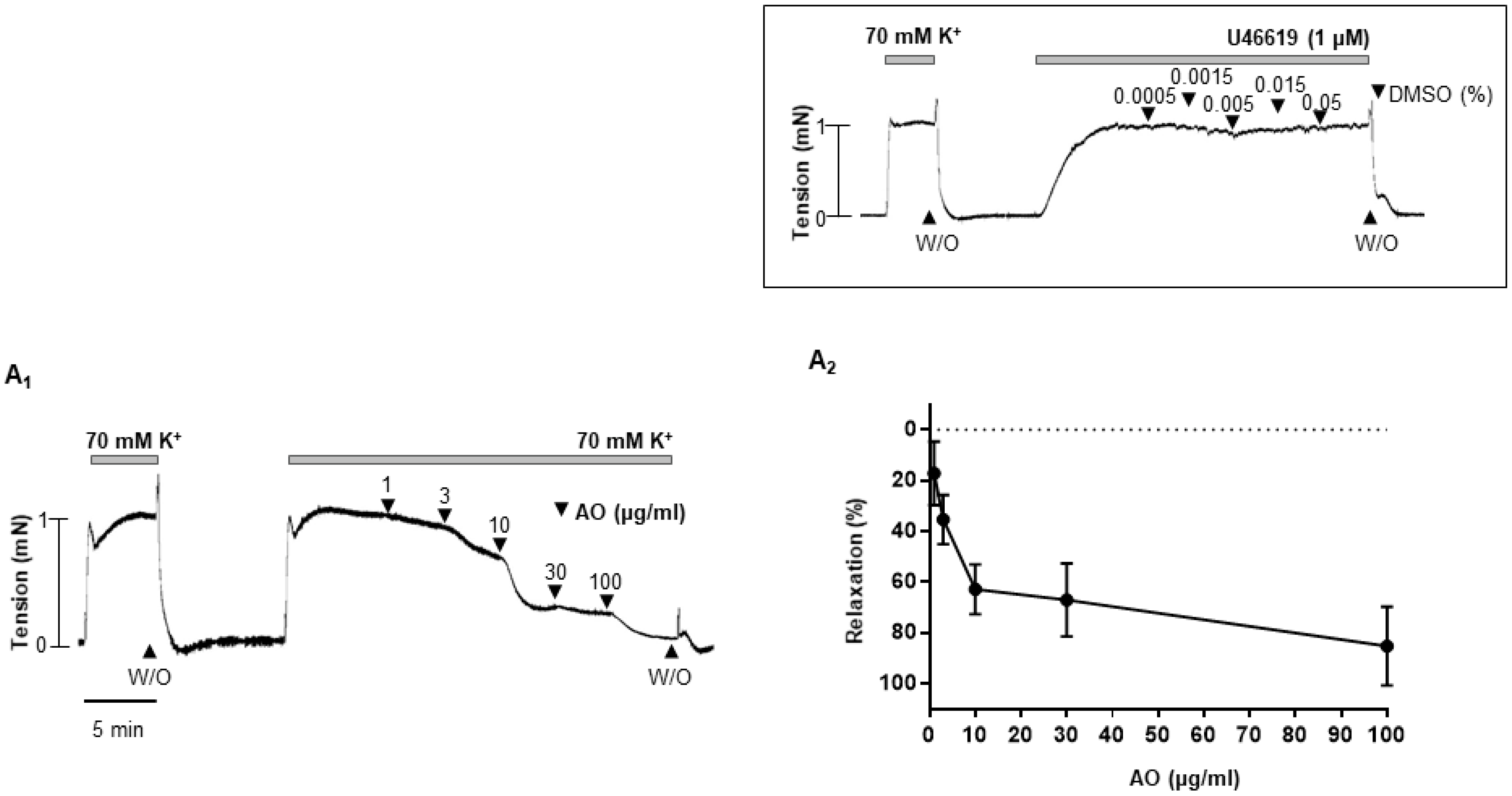

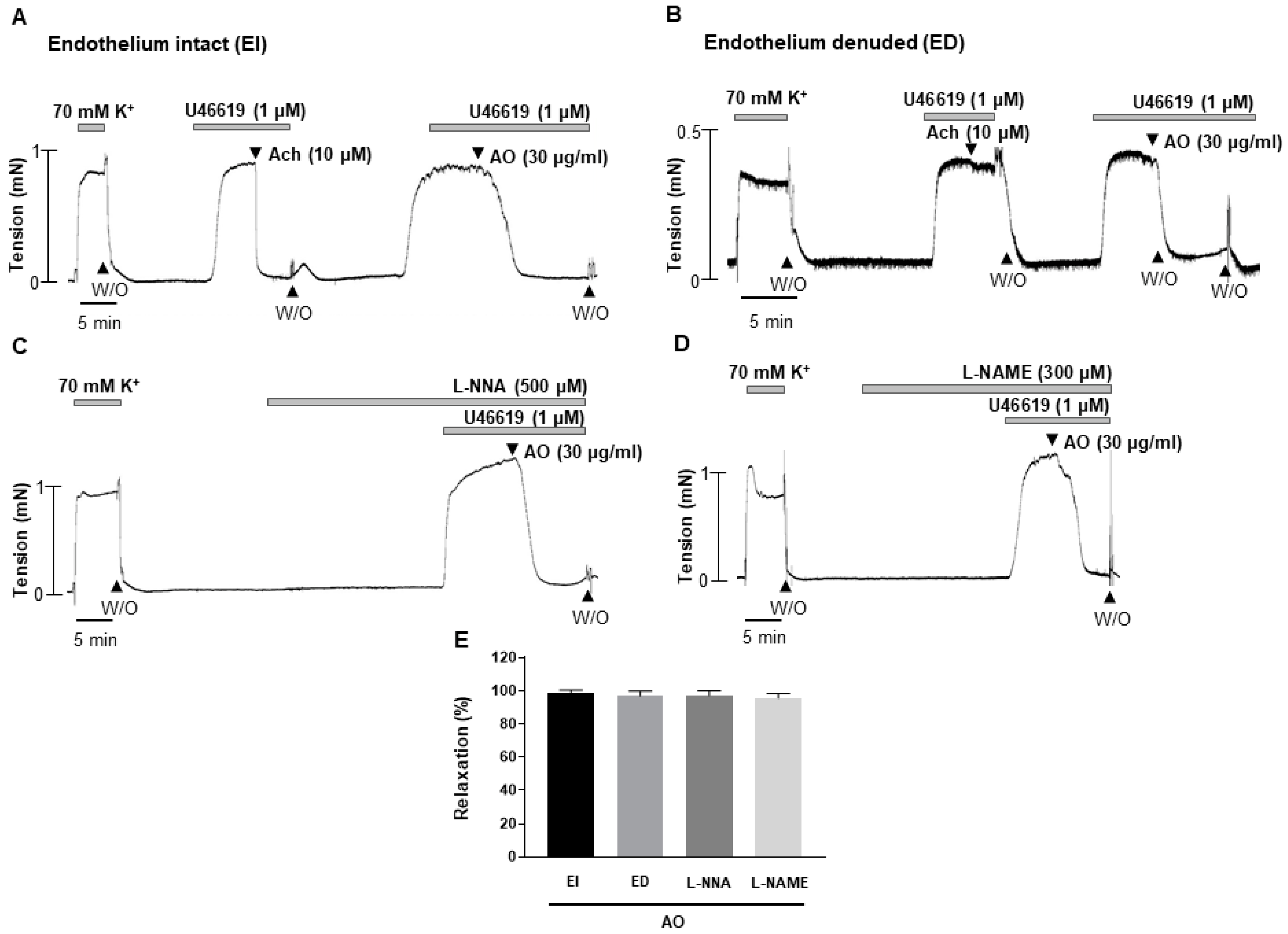
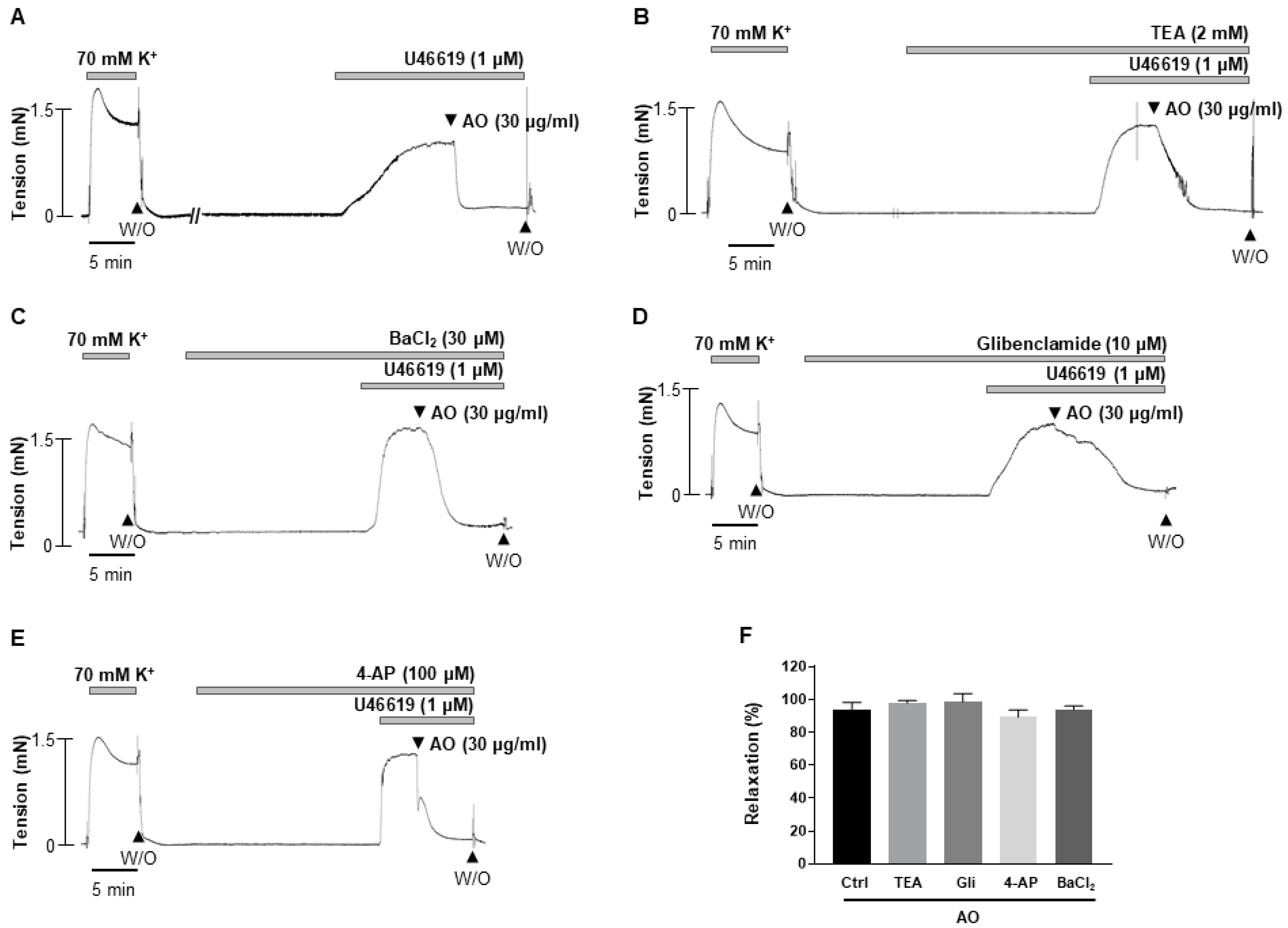
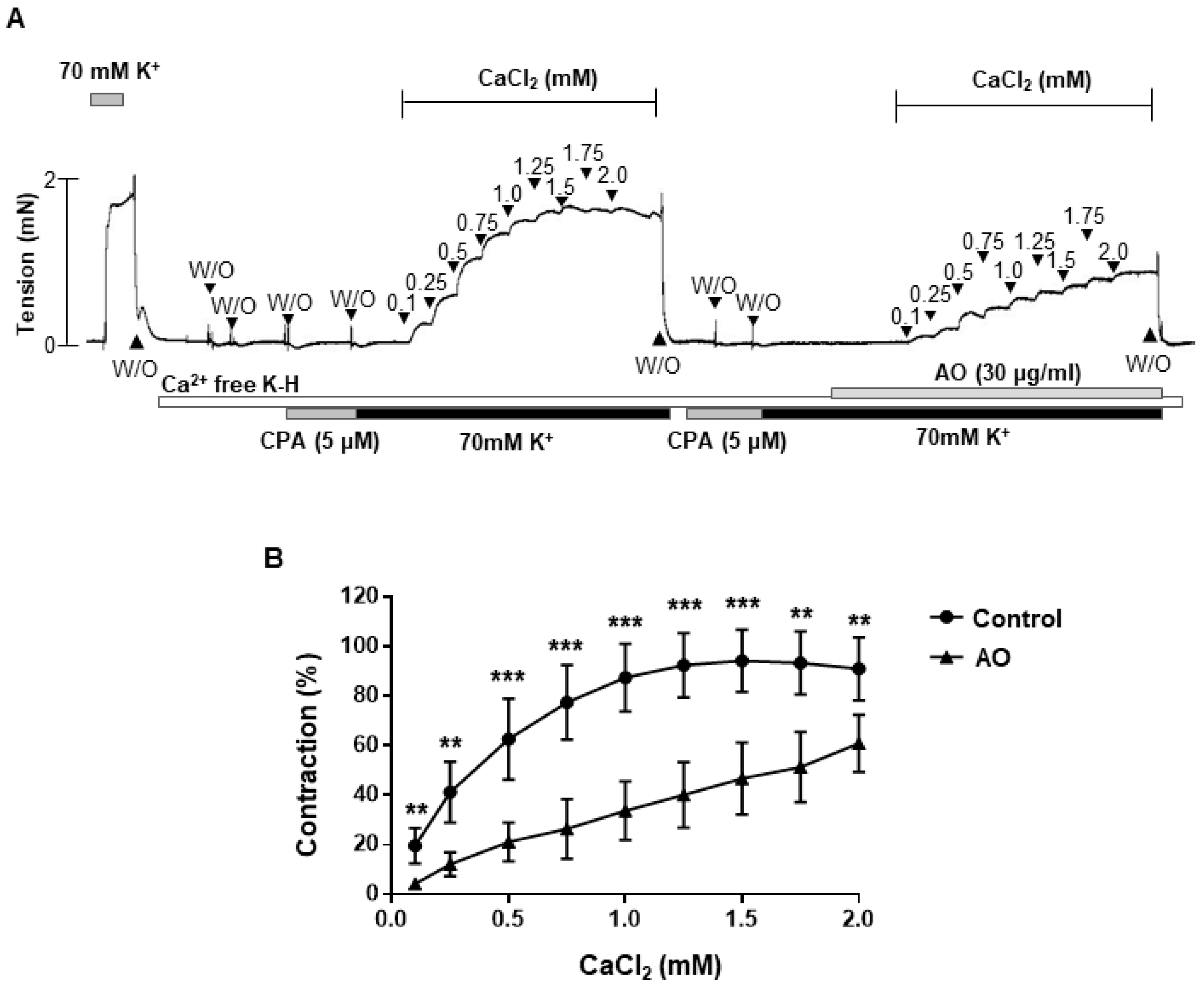
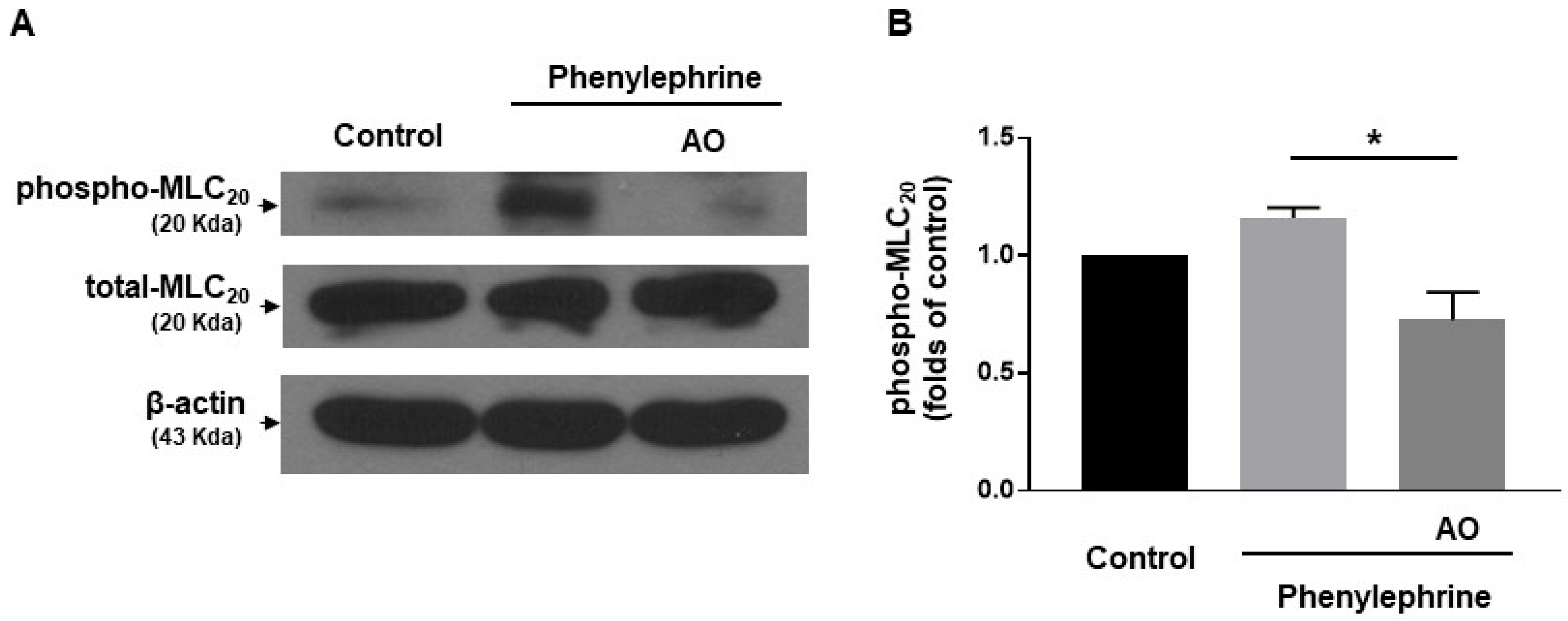
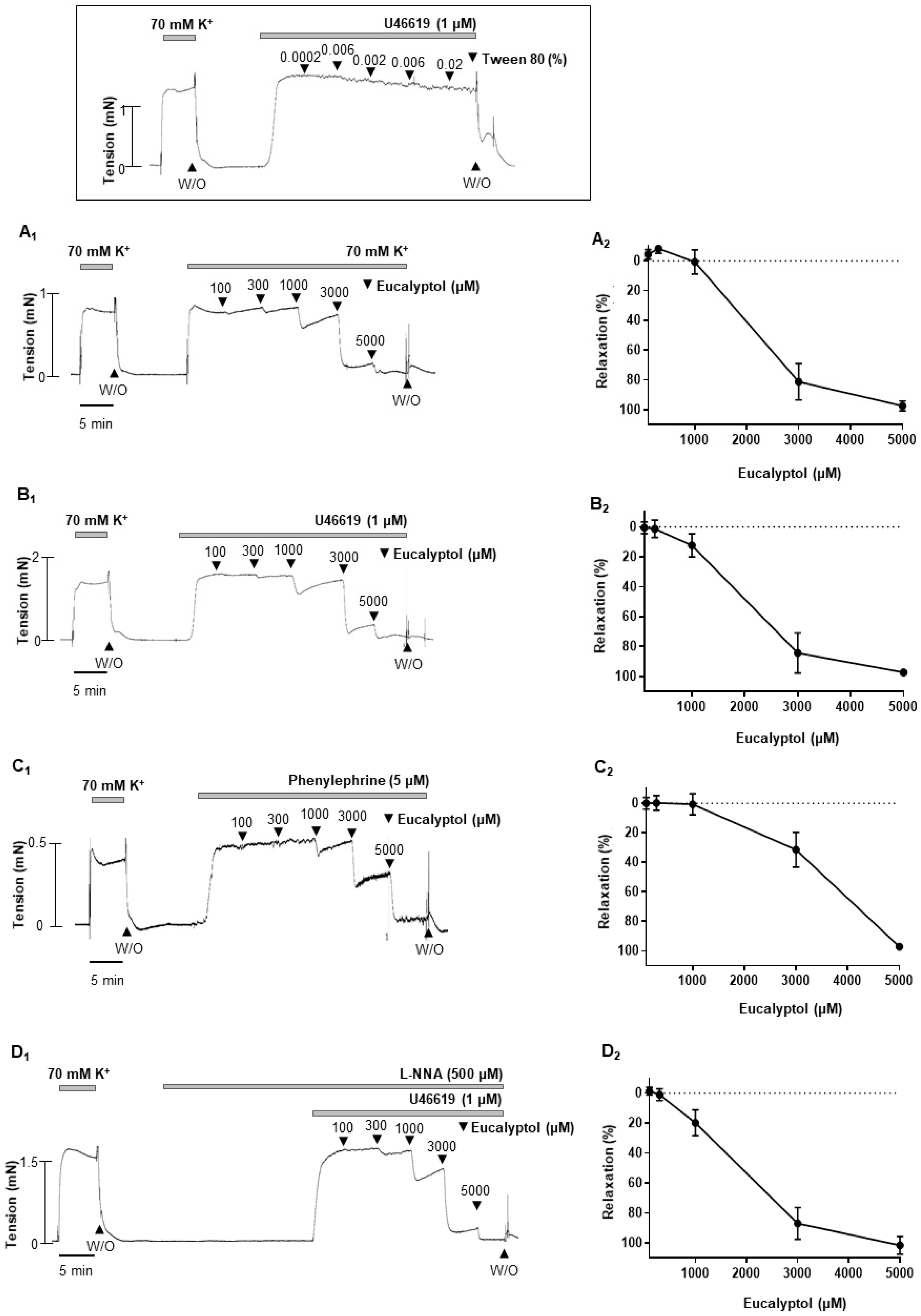
Publisher’s Note: MDPI stays neutral with regard to jurisdictional claims in published maps and institutional affiliations. |
© 2022 by the authors. Licensee MDPI, Basel, Switzerland. This article is an open access article distributed under the terms and conditions of the Creative Commons Attribution (CC BY) license (https://creativecommons.org/licenses/by/4.0/).
Share and Cite
Haam, C.E.; Byeon, S.; Choi, S.J.; Lim, S.; Choi, S.-K.; Lee, Y.-H. Vasodilatory Effect of Alpinia officinarum Extract in Rat Mesenteric Arteries. Molecules 2022, 27, 2711. https://doi.org/10.3390/molecules27092711
Haam CE, Byeon S, Choi SJ, Lim S, Choi S-K, Lee Y-H. Vasodilatory Effect of Alpinia officinarum Extract in Rat Mesenteric Arteries. Molecules. 2022; 27(9):2711. https://doi.org/10.3390/molecules27092711
Chicago/Turabian StyleHaam, Chae Eun, Seonhee Byeon, Soo Jung Choi, Soyeon Lim, Soo-Kyoung Choi, and Young-Ho Lee. 2022. "Vasodilatory Effect of Alpinia officinarum Extract in Rat Mesenteric Arteries" Molecules 27, no. 9: 2711. https://doi.org/10.3390/molecules27092711
APA StyleHaam, C. E., Byeon, S., Choi, S. J., Lim, S., Choi, S.-K., & Lee, Y.-H. (2022). Vasodilatory Effect of Alpinia officinarum Extract in Rat Mesenteric Arteries. Molecules, 27(9), 2711. https://doi.org/10.3390/molecules27092711





